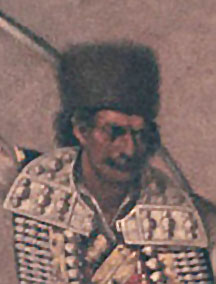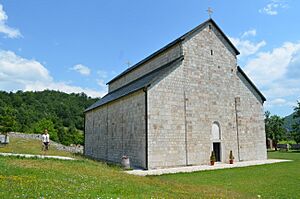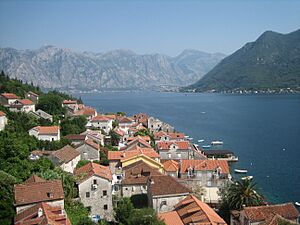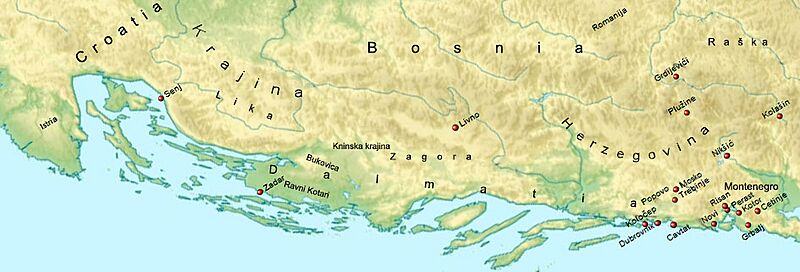Bajo Pivljanin facts for kids
Quick facts for kids
Bajo Pivljanin
|
|
|---|---|

Detail from Bajo Pivljanin kills a Turk (1878)
|
|
| Birth name | Dragojlo Nikolić |
| Born | c. 1630 Piva, Sanjak of Herzegovina (now Montenegro) |
| Died | 7 May 1685 (aged c. 55) Vrtijeljka, near Cetinje, Prince-Bishopric of Montenegro |
| Allegiance | |
| Years of service | 1656–85 |
| Rank |
|
| Battles/wars |
|
Bajo Pivljanin (born Dragojlo Nikolić around 1630) was a famous Montenegrin and Serbian hajduk leader. A hajduk was like a freedom fighter or rebel who protected Christians from Ottoman rule. Bajo was active in areas like Herzegovina and southern Dalmatia, which were then part of the Ottoman Empire.
He was born in Piva, a region in what is now Montenegro. People say he became a hajduk after facing unfair treatment from the Ottomans. In 1656, he started working for the Republic of Venice, who used hajduks to defend their lands in Dalmatia.
Bajo quickly became a respected leader, rising to the rank of harambaša (a top hajduk commander). After a war that didn't go well for Venice, Bajo and other hajduks had to leave their safe area. They became refugees in Dalmatia for many years. When another war started, Bajo returned to defend the border. In 1685, he died fighting against a powerful Ottoman army. Today, Bajo Pivljanin is remembered as a brave hero in Serbian epic poems.
Contents
Bajo's Early Life
Dragojlo Nikolić, known as Bajo Pivljanin, was born around 1630 in Piva, which was then part of the Ottoman Empire. His nickname "Bajo" came from a word meaning "snake," which people believed would protect children from bad luck.
Bajo grew up as an oxen trader, a common and profitable job back then. He often sold his oxen in the Risan market and became quite wealthy.
According to old stories, Bajo became a hajduk after a serious conflict with an Ottoman leader named Asan-aga Kopčić. This event forced him to leave his home and become a rebel. He then led a group of 30 hajduks.
Another popular story tells how Bajo was engaged to a girl named Milica. However, an Ottoman Pasha wanted to marry her instead. Bajo confronted them, and a fight broke out. He stood up for himself and his family, which led to him burning down the Pasha's house and a mosque. This made him a wanted man, and he had to leave his village and become a full-time hajduk. He found shelter in Morača, a place known for its defiant rebels.
Fighting in the Cretan War
The Cretan War (1645–69) was a long conflict between the Republic of Venice and the Ottoman Empire. Venice hired hajduks, who were Ottoman subjects, to fight as guerrilla soldiers. These hajduks would cross into Venetian territory and launch attacks into Ottoman lands.
Bajo was first mentioned in 1654 as one of 1,500 hajduks fighting for Venice. He mostly fought in southern Dalmatia and Herzegovina, where many people were against Ottoman rule. Bajo was also a close friend of Metropolitan Vasilije, an important Serbian Orthodox bishop.
Around 1655, Bajo started leading his own group of hajduks. They carried out a very successful raid on Trebinje in March 1655, taking many prisoners and valuable goods. These raids caused problems between the Republic of Ragusa (a neutral city-state) and the Ottomans.
By 1658, Bajo and his hajduks were so powerful in Herzegovina that they collected taxes from villages. They would send groups of 10-12 hajduks to collect these taxes, and anyone who refused was punished. The main base for the hajduks became Perast in the Bay of Kotor, from where they launched their attacks.
Bajo quickly moved up in the hajduk ranks. In 1664, he was simply called "Bajo hajduk." By 1666, he was a "buljubaša" (captain), and by 1668, he was a "higher harambaša" (a top bandit leader).
Bajo was known for his quick attacks and for destroying bridges when retreating to stop his enemies. For example, he destroyed a stone bridge on the Tara River after raiding Kolašin. In 1664, Bajo and other hajduk leaders attacked a merchant caravan near Ragusa, taking many expensive goods. The Venetian government warned the hajduks to stop provoking the Ottomans, as they feared new attacks.
In 1665, Bajo suffered a big defeat by the Ottomans at Grdijevići, losing most of his men. This forced him to leave his home region. In 1666, Bajo raided a ship carrying Venetian goods and also a rich Ottoman caravan. He claimed that the Venetian governor had given him permission to take whatever he found.
The war ended in 1669 with an Ottoman victory. Venice had to give back most of the land taken by the hajduks. The peace agreement was signed in 1671.
Life Between Wars
After the war, the Venetian areas in the Bay of Kotor were in bad shape. War, hunger, and sickness had reduced the population. The hajduks, who were used to living off war spoils, found peacetime difficult. Venice also wanted to avoid new conflicts with the Ottomans, so the hajduks became a problem.
In 1669, Venetian officials met with hajduk leaders, including Bajo Pivljanin, to discuss how they could live a normal life. The leaders asked if the hajduks could settle in Risan or Vrana and receive benefits, as there were 1,500 hajduks who needed a place to live.
In 1670, Venice decided to let the hajduks settle in Risan. But soon, conflicts broke out between the hajduks and the Ottomans. To keep the peace, Venice decided to move the hajduks to Istria, a region on the northern Adriatic coast.
In May 1671, about 1,300 hajduks were moved by sea to Istria. Istria needed people because many had died from sickness. Venice offered the hajduks tax breaks, land, livestock, and tools. However, many hajduks were not happy. They didn't like the climate and felt that Venice didn't keep all its promises.
Many hajduks moved back to Dalmatia or even to Senj, where other rebels were active. Bajo Pivljanin and his friend Njegošević helped many hajduks move. In 1673, Bajo went to Venice to ask the Doge (the leader of Venice) to stop the persecution of hajduks. His request was partly granted, and some hajduks were freed.
In 1674, Bajo, Jovo Sikimić, and Njegošević settled in Zadar. There, Bajo became friends with Stojan Janković, another famous hajduk. Bajo's brother, Dimitrije, married Stojan's sister. Bajo himself had a son named Simeon in 1676.
After the Ottomans lost a major battle at Vienna in 1683, people in Dalmatia started attacking them. Bajo and his brother joined these rebels. Venice, wanting to avoid war, tried to calm the situation. However, Venice soon joined an alliance against the Ottomans and declared war in 1684. Bajo Pivljanin was back in active service for Venice.
The Morean War
Bajo Returns to Service
Between January and April 1684, Venice welcomed many families, including 20,000 warriors, to settle on their border. They provided them with food and weapons. Bajo and his brother Dimitrije served in the cavalry in Zadar. However, the Venetian governor of Kotor asked for them to be sent to the Bay of Kotor, which was approved.
In September 1684, Bajo was with his group in Herceg Novi. The Venetian Senate thanked Bajo and Jovan Sikimić for a victory they had at Jezero and rewarded them with medals and coins. In March 1685, Bajo reported that his group of 130 fighters had attacked a caravan and burned a village.
The Battle of Vrtijeljka
Süleyman, the Ottoman governor of Scutari, threatened to destroy the Montenegrin people because of their ties with the hajduks. Historians are not sure if the Montenegrins betrayed the hajduks in the battle that followed. Some believe they promised Bajo's head to the Ottomans to avoid punishment.
Süleyman's Ottoman forces marched towards Cetinje. The hajduks, numbering about 1,200 fighters, met them at the hill of Vrtijeljka on May 7, 1685. The hajduks carried a war flag with Venetian symbols.
The Ottomans defeated the hajduks, and Bajo Pivljanin was killed in the battle. Süleyman sent Bajo's head to the Ottoman Sultan as a great war trophy. Süleyman was then promoted to Pasha. News of the battle reached Rome, stating that Bajo and another brave leader had died, and that the defeat was due to betrayal by some Montenegrins.
After the Battle
Bajo's death was a big loss for Venice. A Venetian official noted that "since the death of harambaša Bajo, the frontier is left without leaders able to control the hajduks bands." It is believed that Bajo was buried near the Vlah Church in Cetinje.
In 1685, Bajo's brother Dimitrije asked that Bajo's pay be given to his widow and two sons. He reminded Venice that Bajo had left his home to fight for the Republic and was a very valuable fighter. In 1689, Venice decided to admit Bajo's brother Dimitrije and his two sons, Vuk and Sima, into the Venetian cavalry, recognizing Bajo's bravery and service.
Bajo's Legacy
Bajo Pivljanin is a very important figure in Serbian history and folklore. Many epic poems and stories are told about his life and bravery. A famous Montenegrin ruler and poet, Petar II Petrović-Njegoš, even praised him in his famous work The Mountain Wreath. Historian Ilarion Ruvarac called him a "glorious knight."
The village of Bajovo Polje ("Bajo's field") was named after him. It's said that he killed his first Ottoman enemy there. A Yugoslav Partisan army unit was also named after him. Today, you can find streets named after Bajo Pivljanin in many cities and towns in Serbia, Montenegro, and Bosnia and Herzegovina. There's even a futsal club in Montenegro called KMF Bajo Pivljanin.
Many families claim to be related to Bajo or his brothers. For example, the Bajovići family has different stories about their connection to him. Some say they are direct descendants, while others say they took over his estate.
Epic Poems About Bajo
The Cretan War period is often called an "epical period of Serb history." Vuk Karadžić, a famous Serbian linguist, collected many poems about Bajo Pivljanin. These poems are part of the "hajduk epic cycle" and tell exciting stories about his adventures.
Some of the famous poems include:
- Bajo Pivljanin i beg Ljubović ("Bajo Pivljanin and Bey Ljubović"): This poem tells about Bajo's victory in a duel.
- Sa šta Pivljanin Bajo ode u uskoke ("Why did Pivljanin Bajo became an uskok"): This poem describes why he became a hajduk.
- Bajo Pivljanin i Ale Novljanin ("Bajo Pivljanin and Ale from Novi"): Another story of his battles.
- Pivljanin Bajo i Ferat kapetan ("Bajo Pivljanin and captain Ferhat"): Bajo recovers stolen sheep in this tale.
- Boj na Vrtijeljci ("Battle of Vrtijeljka"): This poem describes the battle where Bajo was killed.
|
Annotations






